Related Research Articles

Nagasaki Prefecture is a prefecture of Japan located on the island of Kyūshū. Nagasaki Prefecture has a population of 1,314,078 and has a geographic area of 4,130 km2. Nagasaki Prefecture borders Saga Prefecture to the northeast.
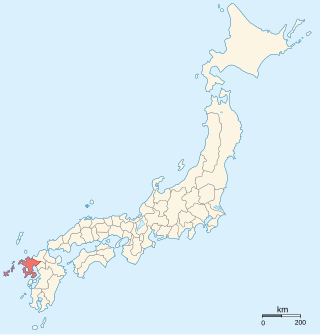
Hizen Province was an old province of Japan in the area of the Saga and Nagasaki prefectures. It was sometimes called Hishū (肥州), with Higo Province. Hizen bordered on the provinces of Chikuzen and Chikugo. The province was included in Saikaidō. It did not include the regions of Tsushima and Iki that are now part of modern Nagasaki Prefecture.
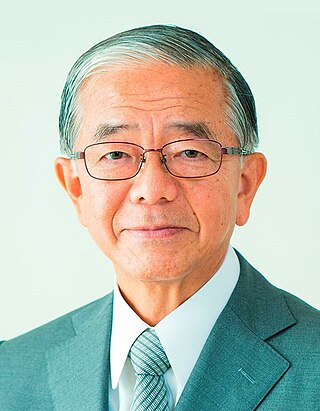
Genjirō Kaneko is a Japanese politician and member of the Liberal Democratic Party. Kaneko served as Minister of Agriculture, Forestry and Fisheries from October 2021 to August 2022. He has also represented the Nagasaki At-large district in the House of Councillors since his election in the July 2010 Councillors election. Kaneko is a native of Ikitsuki, Nagasaki and graduate of Keio University.
Events in the year 2007 in Japan.
Events in the year 2010 in Japan.
The 16th unified local elections in Japan took place in April 2007. In the first phase on April 8, 2007 13 governors, 44 prefectural assemblies as well as four mayors and 15 assemblies in cities designated by government ordinance were elected. In the second phase on April 22, 2007 mayors and/or assemblies in hundreds of cities, special wards, towns and villages were up for election. Additionally, by-elections for the national Diet were held in Fukushima and Okinawa on April 22.
Events in the year 2012 in Japan.
Politics of Kanagawa, as in all prefectures of Japan, takes place in the framework of local autonomy that is guaranteed by the Constitution and laid out in the Local Autonomy Law. The administration is headed by a governor directly elected by the people every four years in first-past-the-post elections. Legislation, the budget and the approval of personnel appointments, including the vice governors, are handled by the prefectural assembly that is directly elected by the people every four years by single-non transferable vote.
Politics of Osaka, as in all 47 prefectures of Japan, takes place in the framework of local autonomy that is guaranteed by chapter 8 of the Constitution and laid out in the Local Autonomy Law. The administration is headed by a governor directly elected by the people every four years in first-past-the-post elections. Legislation, the budget and the approval of personnel appointments, including the vice governors, are handled by the prefectural assembly that is directly elected by the people every four years by single-non transferable vote.

The Mie Prefectural Assembly is the prefectural parliament of Mie.

The Aichi Prefectural Assembly is the legislative assembly of Aichi Prefecture.
Nagasaki 3rd district is a single-member electoral district for the House of Representatives, the lower house of the National Diet of Japan. It is located in the prefecture of Nagasaki. It covers parts of Nagasaki on the main island of Kyūshū – the city of Ōmura and the towns of Kawatana, Hasami and Higashisonogi, Nagasaki in former Higashi-Sonogi-gun – and several of the prefecture's island municipalities: the cities of Iki, Tsushima and Gotō and the town of Shin-Kamigotō in Minami-Matsuura/"South Matsuura" district. As of September 2011, 211,289 eligible voters were registered in Nagasaki 3rd district, giving it the second highest vote weight in the country.
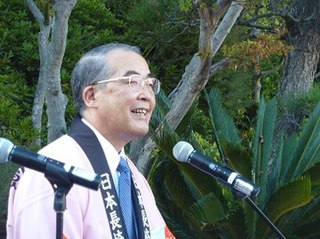
Hōdō Nakamura is a Japanese politician and a former governor of Nagasaki Prefecture located in the Kyushu region of Japan. He was re-elected for another four-year term as governor in both 2014 and 2018. Nakamura ran for a fourth term in 2022, but lost the elections.
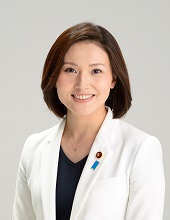
Megumi Kaneko is a Japanese politician. She served as a member of the House of Representatives for the Liberal Democratic Party (LDP) between 2012 and 2017, when she represented the 4th District of Niigata prefecture. She was defeated in the 2017 general election.
A gubernatorial election was held on 4 February 2018 to elect the next governor of the Nagasaki Prefecture. Incumbent Governor Hōdō Nakamura ran for a third consecutive term, challenged by Toshihiko Haraguchi from the Japanese Communist Party.
Haru Nishioka was a Japanese businesswoman and politician who was a member of the House of Councillors.
A gubernatorial election was held on 3 February 2002 to elect the next governor of Nagasaki, a prefecture of Japan in the north-west of the island of Kyushu.
A gubernatorial election was held on 5 february 2006 to elect the next governor of Nagasaki, a prefecture of Japan in the north-west of the island of Kyushu.
A gubernatorial election was held on 21 february 2010 to elect the next governor of Nagasaki, a prefecture of Japan in northwestern area of the island of Kyushu.
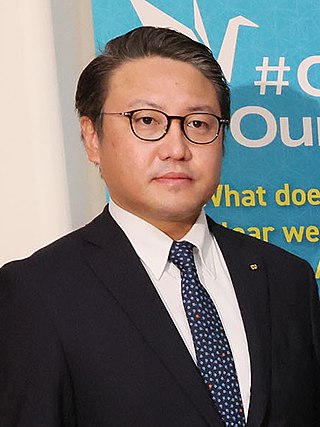
A gubernatorial election was held on 20 February 2022 to elect the next governor of Nagasaki, a prefecture of Japan in the north-west of the island of Kyushu.
References
- ↑ Nagasaki Prefectural Government: 5. current fiscal situation [ permanent dead link ]
- ↑ The Wall Street Journal, February 2, 2014: 長崎県知事に中村氏再選=共産新人破る Archived 2014-02-22 at the Wayback Machine
- ↑ Nagasaki Prefectural Assembly: Electoral district map
- ↑ Nagasaki Prefectural Assembly: Members by parliamentary group
- ↑ 渡辺敏勝
- ↑ 中山功
- ↑ Nagasaki Prefectural Assembly: List of assembly presidents and vice presidents since 1879